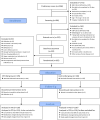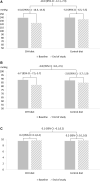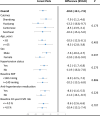Effects of Cuisine-Based Chinese Heart-Healthy Diet in Lowering Blood Pressure Among Adults in China: Multicenter, Single-Blind, Randomized, Parallel Controlled Feeding Trial
- PMID: 35861850
- PMCID: PMC9311470
- DOI: 10.1161/CIRCULATIONAHA.122.059045
Effects of Cuisine-Based Chinese Heart-Healthy Diet in Lowering Blood Pressure Among Adults in China: Multicenter, Single-Blind, Randomized, Parallel Controlled Feeding Trial
Abstract
Background: More than one-fifth of the world's population consumes Chinese cuisines regularly, but no evidence-based healthy diets fitting the Chinese food culture are available for implementation.
Methods: A multicenter, patient- and outcome assessor-blind, randomized feeding trial was conducted among 265 participants with 130 to 159 mm Hg baseline systolic blood pressure (SBP) for 4 major Chinese cuisines (Shangdong, Huaiyang, Cantonese, Szechuan). After a 7-day run-in period on a control diet matching the usual local diets, participants were randomized to continue with the control diet or the cuisine-based Chinese heart-healthy diet for another 28 days. The primary outcome was SBP, and secondary outcomes included diastolic blood pressure and food preference score. Linear regression models were used to estimate the intervention effects and adjustments for the center. The incremental cost per 1 mm Hg reduction in SBP was also calculated.
Results: A total of 265 participants were randomized (135 on the Chinese heart-healthy diet and 130 on the control diet), with 52% women, mean age of 56.5±9.8 years, and mean SBP and diastolic blood pressure of 139.4±8.3 and 88.1±8.0 mm Hg, respectively, at baseline. The change in SBP and diastolic blood pressure from baseline to the end of the study in the control group was -5.0 (95% CI, -6.5 to -3.5) mm Hg and -2.8 (95% CI, -3.7 to -1.9) mm Hg, respectively. The net difference of change between the 2 groups in SBP and diastolic blood pressure were -10.0 (95% CI, -12.1 to -7.9) mm Hg and -3.8 (95% CI, -5.0 to -2.5) mm Hg, respectively. The effect size did not differ among cuisines (P for interaction=0.173). The mean food preference score was 9.5 (with 10 the best preferred) at baseline, and the net change during intervention was 0.1 (95% CI, -0.1 to 0.2; P=0.558). The incremental cost-effectiveness ratio per 1 mm Hg SBP reduction was CNY 0.4 (USD 0.06) per day. No difference in the number of adverse events was found between the 2 groups (P=0.259), and none of the adverse events was associated with the intervention.
Conclusions: The Chinese heart-healthy diet is effective, palatable, and cost-effective in reducing blood pressure in Chinese adults with high blood pressure, with a clinically significant effect applicable across major Chinese cuisine cultures.
Registration: URL: https://www.
Clinicaltrials: gov; Unique identifier: NCT03882645.
Keywords: China; adult; blood pressure; healthy diet; hypertension.
Figures




References
-
- Roth GA, Mensah GA, Johnson CO, Addolorato G, Ammirati E, Baddour LM, Barengo NC, Beaton AZ, Benjamin EJ, Benziger CP; GBD-NHLBI-JACC Global Burden of Cardiovascular Diseases Writing Group. Global burden of cardiovascular diseases and risk factors, 1990-2019: update from the GBD 2019 Study. J Am Coll Cardiol. 2020;76:2982–3021. doi: 10.1016/j.jacc.2020.11.010 - PMC - PubMed
-
- Huang L, Trieu K, Yoshimura S, Neal B, Woodward M, Campbell NRC, Li Q, Lackland DT, Leung AA, Anderson CAM, et al. . Effect of dose and duration of reduction in dietary sodium on blood pressure levels: systematic review and meta-analysis of randomised trials. BMJ. 2020;368:m315. doi: 10.1136/bmj.m315 - PMC - PubMed
Publication types
MeSH terms
Substances
Associated data
LinkOut - more resources
Full Text Sources
Other Literature Sources
Medical

